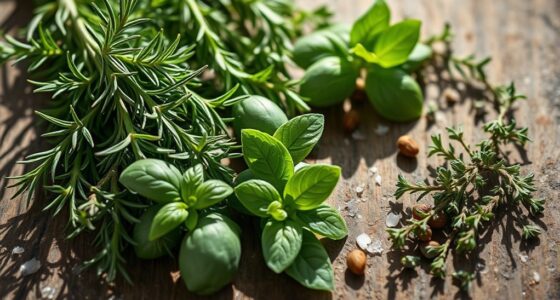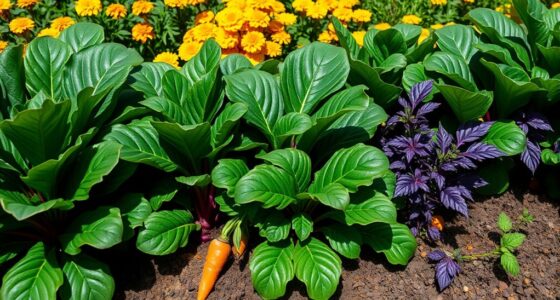Imagine stepping into your garden, the air filled with the refreshing aroma of lemon balm, inviting you to explore the vibrant life thriving all around it. Growing lemon balm (Melissa officinalis) is more than just caring for an aromatic herb; it’s an opportunity to cultivate a space that nurtures not only your senses but also the harmonious relationships between plants. By discovering the best companion plants for lemon balm, you create a supportive ecosystem that enhances growth, flavor, and health. Join us as we unveil the ideal lemon balm garden companions that promise to transform your gardening experience.
Key Takeaways
- Lemon balm is an aromatic herb known for its delightful scent and easy maintenance.
- Companion planting with lemon balm can boost the vitality of your garden.
- Choosing the right companions enhances growth and pest resistance.
- Understanding plant relationships helps optimize your lemon balm garden companions.
- Strategically pairing plants leads to a flourishing and aromatic space.
What is Lemon Balm and Its Benefits?
Lemon balm, known scientifically as Melissa officinalis, stands out as a versatile perennial herb. This herb not only boasts a delightful aroma but also has a rich history of usage. Its soft green leaves release a refreshing scent when brushed, adding to its appeal in gardens and kitchens. Beyond its culinary uses, the benefits of lemon balm extend into wellness, where its calming properties are particularly valued.
Overview of Lemon Balm
With origins in southern Europe, lemon balm has been cultivated for centuries. The plant produces delicate white flowers that bloom in summer, attracting various beneficial insects such as bees and butterflies. Often considered a must-have herb, lemon balm is cherished for both its aesthetic appeal in gardens and its myriad uses in herbal teas, essential oils, and other natural remedies.
Health Benefits of Lemon Balm
The lemon balm health benefits are noteworthy, particularly in promoting relaxation and relieving stress. Many people turn to lemon balm as a natural aid for improving sleep quality and soothing anxiety. Its properties may help support cognitive function, enhancing focus and mental clarity. Incorporating lemon balm into your daily routine can lead to a more balanced and tranquil lifestyle.
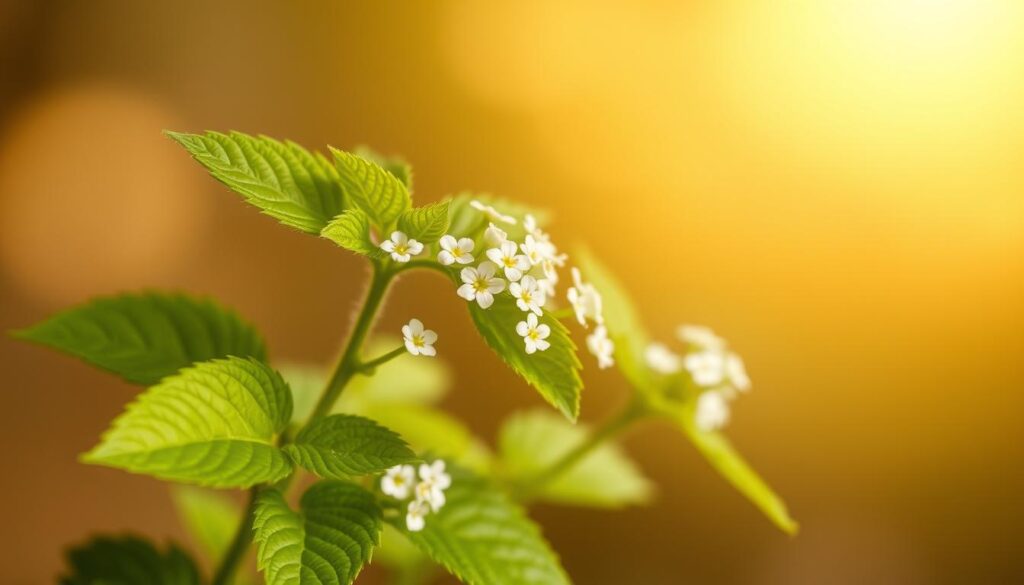
Ideal Growing Conditions for Lemon Balm
Understanding the ideal growing conditions for lemon balm is essential for cultivating a healthy and productive herb. This plant thrives when its specific soil, light, water, and temperature needs are met. Get ready to dive into the specifics so you can create the perfect environment for your lemon balm.
Soil Requirements
Lemon balm flourishes in rich, well-draining soil that retains moisture while allowing excess water to escape. The optimal pH level for the soil requirements for lemon balm ranges between 6.0 and 7.0. Incorporating organic matter such as compost can significantly enhance soil quality, providing essential nutrients to support growth.
Light and Water Needs
This herb enjoys a mix of full sun and partial shade. Striking a balance in light is vital, as too much direct sunlight can stress the plant, while insufficient light can inhibit growth. Regular watering is equally important, especially during warmer months. Your lemon balm prefers consistently moist soil, so be attentive to its light and water needs for lemon balm.
Temperature Considerations
Lemon balm adapts to various temperature ranges but performs best in temperate climates. The herb enjoys moderate warmth, thriving when daytime temperatures hover around 70-75°F. Protecting it from frost will ensure a longer growing season, maintaining your plant’s vitality and productivity.
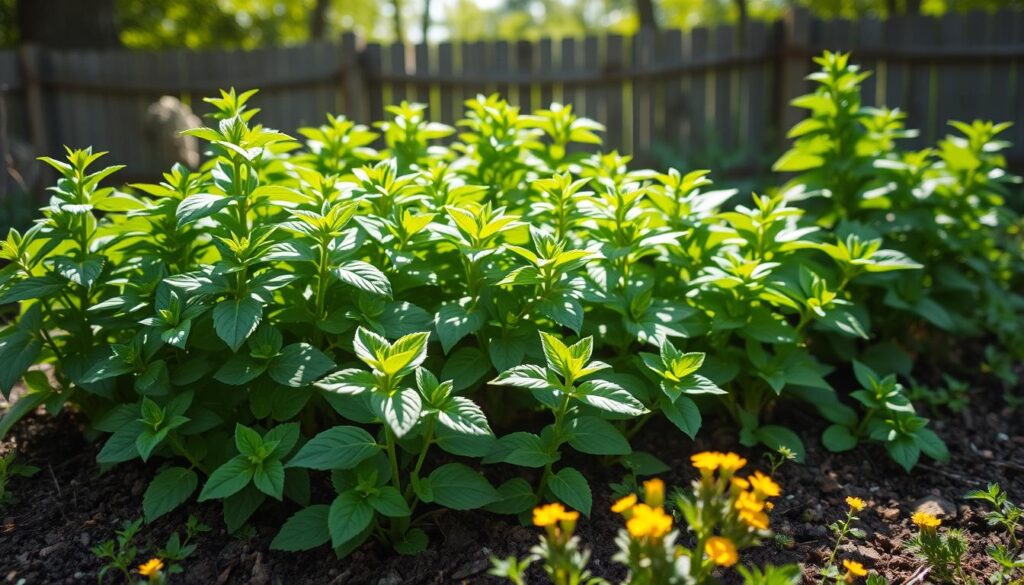
Why Companion Planting Matters
Companion planting plays a significant role in creating a vibrant and productive garden. By selecting compatible plants, you can maximize the health and yield of your garden. The benefits of companion planting extend beyond simple aesthetics, enhancing the overall ecosystem within your garden space.
Benefits of Companion Planting
Understanding the benefits of companion planting helps you make informed choices for your garden. Key advantages include:
- Pest Control: Some plants naturally deter pests that threaten others, creating a protective environment.
- Nutrient Sharing: Certain plants enhance soil nutrients, improving growth for their companions.
- Biodiversity: Increased plant variety boosts the resilience of your garden ecosystem.
How Companion Plants Help Each Other
Understanding how companion plants help can transform your gardening experience. They often provide mutual support that benefits growth and health. For example, plants like marigolds repel detrimental insects, while their vibrant blooms attract pollinators. This synergy fosters a thriving garden atmosphere.

| Plant Type | Pest Management | Nutrient Enhancement |
|---|---|---|
| Marigolds | Repel nematodes and aphids | Improve soil health |
| Basil | Discourages flies and mosquitoes | Boosts flavor in tomatoes |
| Beans | Repels harmful insects | Adds nitrogen to the soil |
Top Companion Plants for Lemon Balm
Choosing the best companion plants for lemon balm enhances not only its growth but also its overall contributions to your garden. Each companion has unique attributes that promote a thriving ecosystem. Explore the standout options for optimal companionship below.
Marigolds: Natural Pest Control
Marigolds are well-known as natural pest control plants. Their vibrant flowers emit a scent that deters harmful insects like nematodes and aphids. When planted alongside lemon balm, these bright blooms create a protective barrier, allowing lemon balm to flourish without the threat of pest infestations.
Basil: Flavor Boost and Health Benefits
Basil pairs beautifully with lemon balm, providing both culinary delight and health benefits. This dynamic duo attracts pollinators, contributing to a more productive garden. Furthermore, basil enriches the soil, creating a supportive environment for herbs that support lemon balm and improve its overall vitality.
Oregano: Attracts Beneficial Insects
Oregano attracts beneficial insects, which can be a game-changer for your garden’s ecosystem. Sharing similar soil and sunlight preferences with lemon balm, oregano thrives in close proximity. Its strong scent not only enhances your garden’s aroma but also complements lemon balm in a symbiotic relationship.
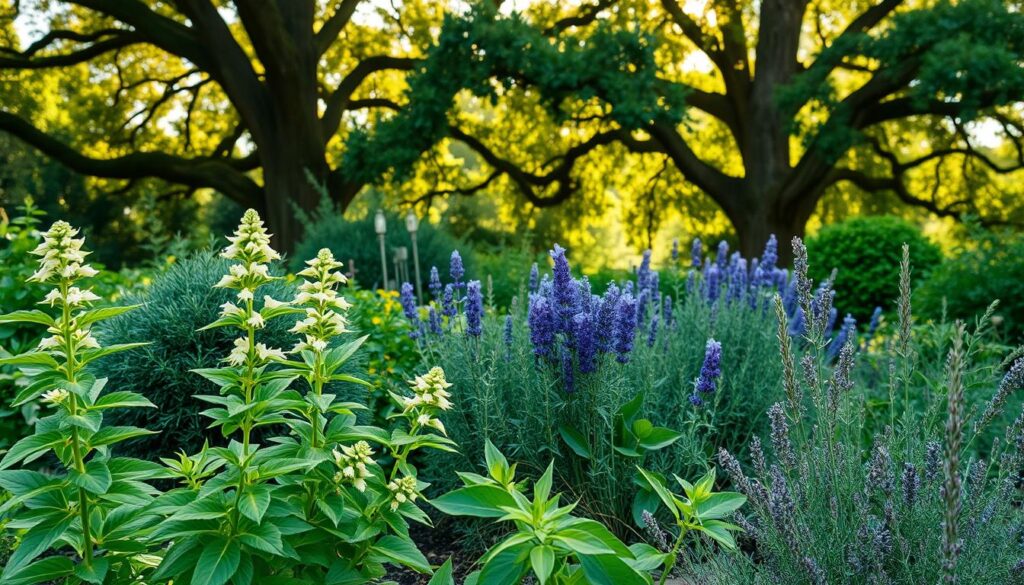
Herbs that Thrive with Lemon Balm
When you cultivate lemon balm, consider pairing it with specific herbs that grow well together. These lemon balm herb companions not only enhance each other’s flavors but also create a harmonious growing environment. Below are three excellent options to elevate your garden.
Mint: Growing Together Harmoniously
Mint is a fantastic herb that thrives in similar moisture-rich conditions as lemon balm. When planted nearby, both herbs benefit from shared resources. Mint’s refreshing flavor can enhance various dishes, making it a perfect addition to cocktails and salads.
Chives: Enhancing Flavor Profiles
Chives offer a distinct taste that perfectly complements the lemony notes of lemon balm. These two herbs can thrive side by side, as lemon balm’s pest-repelling properties help protect chives from common garden pests. This partnership not only boosts flavor profiles but also promotes a healthier growing environment.
Chamomile: A Soothing Partnership
Chamomile enhances the garden atmosphere by attracting pollinators while offering a calming aroma. This herb pairs beautifully with lemon balm, creating a relaxing space in your garden. The soothing qualities of chamomile, combined with lemon balm’s calming properties, make for an ideal blend that contributes to both mental well-being and vibrant garden life.

Vegetables that Pair Well with Lemon Balm
Growing vegetables alongside lemon balm can create a thriving garden. This herb offers more than just flavor; it also provides numerous benefits to its vegetable companions. Certain vegetables that grow well with lemon balm benefit from pest deterrence and enhanced growth, making them excellent choices for your garden.
Tomatoes: Mutual Benefits
Tomatoes and lemon balm make a fantastic team. The presence of lemon balm helps deter pests like aphids and spider mites, allowing your tomatoes to thrive. With similar watering needs, these vegetables create a harmonious growing environment.
Peppers: Flavor Enhancement
Planting peppers near lemon balm can significantly enhance their flavor profile. This herb’s ability to repel harmful pests means your peppers can grow healthier without interference. The complementary nutritional requirements make them ideal lemon balm vegetable companions.
Squash: Companion Support
Squash plants benefit greatly from the companionship of lemon balm. Not only does lemon balm help improve pollination rates, but it also offers protection against common garden pests. This synergy supports robust squash growth, ensuring a bountiful harvest.

Flowers that Complement Lemon Balm
Integrating colorful flowers that pair with lemon balm not only enhances the visual appeal of your garden but also promotes overall plant health. Certain flowers can attract beneficial insects, deter pests, and even improve the soil structure, making them excellent choices as good companion flowers for lemon balm.
Nasturtiums: Attracting Pollinators
Nasturtiums are vibrant, edible flowers that thrive alongside lemon balm. These flowers attract pollinators like bees and butterflies, creating a lively atmosphere in your garden. Additionally, nasturtiums can act as a trap crop, drawing pests away from your lemon balm, which helps maintain its health.
Borage: Nutrient-Rich Companion
Borage is another wonderful flower that pairs well with lemon balm. This plant is known for its star-shaped blue flowers and is rich in nutrients. Borage attracts beneficial insects, such as bees, and can improve soil structure. When planted near lemon balm, it enhances overall growth and vigor, making it a top choice among good companion flowers for lemon balm.
Sunflowers: Structural Support
Sunflowers stand tall and proud, providing structural support for smaller plants in your garden. Their vibrant blooms attract beneficial pollinators and can create a protective microclimate for lemon balm. This synergy fosters a supportive environment, allowing both sunflowers and lemon balm to thrive.
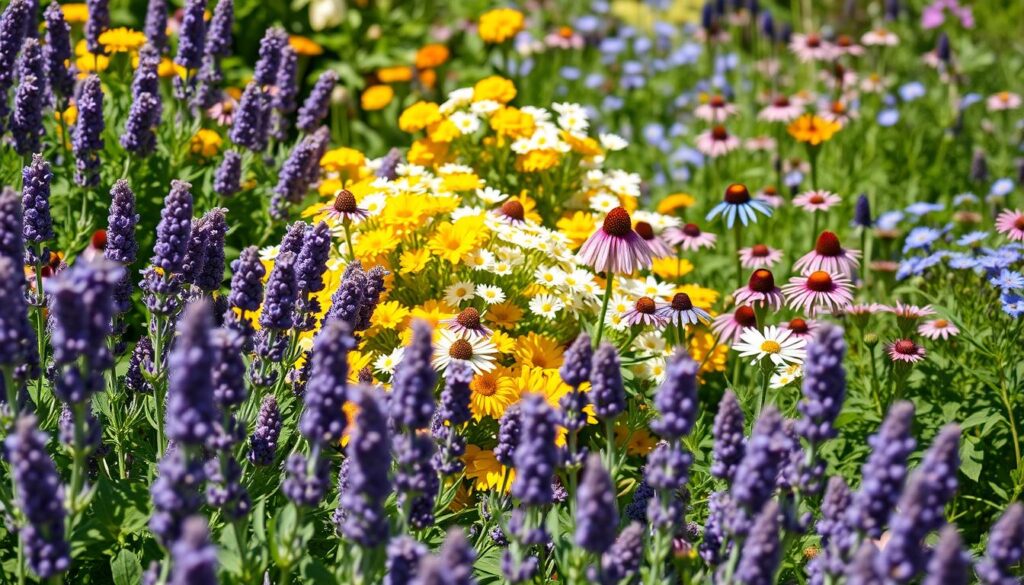
| Flower | Benefits | Best Features |
|---|---|---|
| Nasturtiums | Attracts pollinators; Deterrent to pests | Edible flowers; Bright colors |
| Borage | Improves soil; Attracts beneficial insects | Rich in nutrients; Beautiful blooms |
| Sunflowers | Provides structural support; Attracts pollinators | Tall growth; Vibrant and cheerful |
Avoiding Incompatible Neighbors
While lemon balm thrives alongside many companion plants, some species can hinder its growth. It’s important to recognize the incompatible plants with lemon balm to ensure your garden flourishes without competition or detrimental interactions.
Plants to Steer Clear Of
- Rue: Known for its growth-inhibiting properties, rue can significantly affect lemon balm.
- Black walnut trees: These trees release chemicals that can be harmful to lemon balm’s growth.
- Rosemary: This dry-loving herb often struggles in the moisture-rich conditions preferred by lemon balm.
- Sage: Similar to rosemary, sage may face challenges when paired with lemon balm.
- Mint varieties: These can be quite aggressive, overtaking lemon balm and leading to resource competition.
How Incompatible Plants Harm Each Other
Understanding how incompatible plants with lemon balm affect one another is crucial for maintaining a healthy garden environment. Rue and black walnut trees quickly inhibit growth through allelopathic effects. Similarly, herbs like rosemary and sage may struggle to thrive in a damp atmosphere, leading to subpar health for both plants. The aggressiveness of mint varieties can crowd out lemon balm, denying it necessary nutrients and space. By identifying and avoiding these plants to avoid with lemon balm, you can create a more harmonious growing environment for your vegetable and herb companions.

Crafting a Lemon Balm Companion Garden
Creating your lemon balm companion garden involves insightful planning and a strategic approach to layout. Begin by grouping plants that have similar light and water requirements. This ensures that each plant thrives while minimizing competition for resources. Equally important is understanding the growth habits of each species; too much overcrowding can lead to stunted growth and hinder your garden’s potential.
Layout Tips for Your Garden
When designing your garden layout, consider accessibility. Make sure you can easily reach all plants for maintenance and harvesting. This will encourage you to tend to your garden regularly. Using raised beds or containers for your lemon balm companion garden can facilitate better drainage and ease of access. Ensure you incorporate pathways wide enough for comfortable movement and to provide adequate light to all plants.
Seasonal Planting Strategies
Employing seasonal planting strategies can greatly enhance your garden. Utilize staggered planting to ensure a continuous harvest throughout the growing season. Rotational planting methods will help maintain soil fertility and can reduce the risk of pests and diseases. Change the position of your plants each season to foster a healthy environment and maximize space within your lemon balm companion garden.

Caring for Lemon Balm and Its Companions
Proper care for lemon balm and its companion plants ensures a thriving garden. Employing the right techniques aids in healthy growth and optimal flavor. Below are essential tips for growing lemon balm and maintaining its companions effectively.
Watering and Fertilization
Regular watering remains vital in caring for lemon balm. Aim to keep the soil slightly moist without letting it become waterlogged. Overwatering can lead to root rot, affecting both lemon balm and its neighbors. Fertilization is typically minimal since lemon balm is a low feeder. Incorporating organic compost can enhance nutrient levels, supporting robust growth in companion plants as well.
Pruning and Maintenance Tips
Pruning plays an important role in the maintenance of companion plants. Regularly trimming lemon balm encourages bushy growth and helps control its spread. Monitor all plants in your garden for signs of pests and stress. Vigilance ensures a healthy, balanced ecosystem where lemon balm and its companions can thrive together.
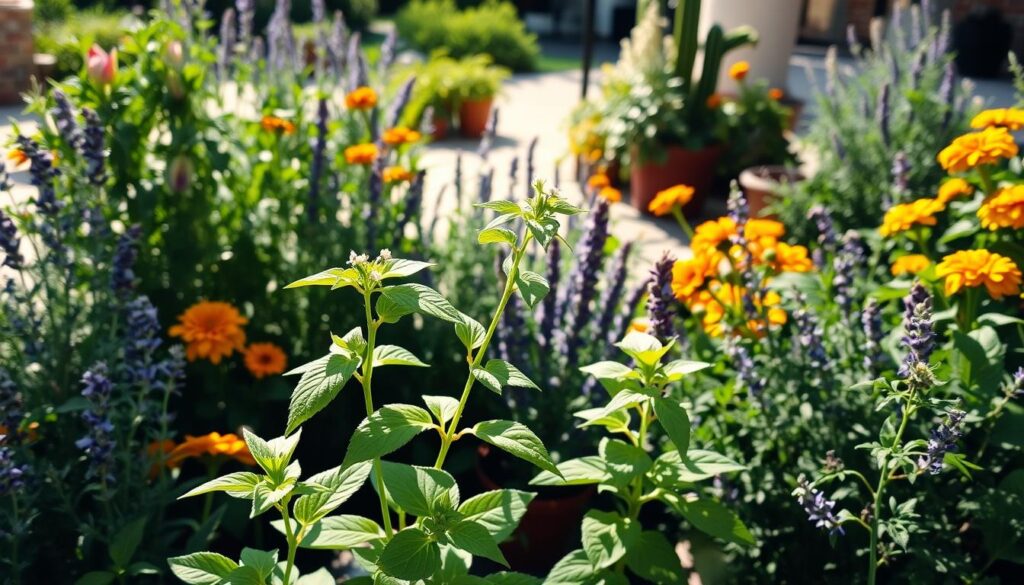
Harvesting Lemon Balm and Companion Plants
When it comes to harvesting lemon balm and companion plants, timing plays a crucial role. Understanding the best time to harvest herbs ensures you enjoy the fullest flavor and aroma in your cooking. Lemon balm is at its peak just before it flowers, allowing you to capture its essential oils effectively.
Best Times to Harvest
The ideal moment for harvesting lemon balm occurs in the late morning after the dew has evaporated. This practice helps retain the aromatic qualities of the herb. Regularly pinch or cut leaves to stimulate further growth, allowing for continual harvesting throughout the season.
Storage Tips for Fresh Herbs
Proper storing of fresh herbs ensures their longevity and flavor retention. For lemon balm and its companions, refrigeration is ideal. You can wrap the herbs in a damp paper towel or place them in jars filled with water, like cut flowers. For long-term storage, consider drying your herbs. Hang them in a well-ventilated area, keeping them out of direct sunlight. These methods of storing fresh herbs will help maximize their use in your favorite dishes.

Using Lemon Balm and Its Companions in the Kitchen
Lemon balm is not just a beautiful plant in your garden; it brings a vibrant, lemony flavor to various culinary creations. Exploring the versatility of this herb opens up a world of delicious possibilities. Whether you’re using lemon balm in cooking or pairing it with other herbs and produce, you will find its unique taste enhances many dishes. Below are some enticing lemon balm flavor pairings and recipe ideas with lemon balm that you can easily try at home.
Flavor Pairings with Lemon Balm
The refreshing taste of lemon balm pairs incredibly well with herbs and fruits, allowing you to get creative in the kitchen. Consider these flavor combinations:
- Lemon Balm and Basil: This duo works beautifully in salads, marinades, and sauces, adding depth to savory dishes.
- Lemon Balm and Chives: Combine them for a delightful herbal butter or in creamy dressings.
- Lemon Balm and Strawberries: A match made for desserts and beverages, enhancing a refreshing summer drink.
- Lemon Balm and Ginger: Perfect for teas and syrups, providing warmth alongside the coolness of lemon balm.
Recipe Ideas Featuring Your Companion Plants
Incorporating lemon balm into your meals can be easy and fun. Here are some simple recipe ideas with lemon balm to inspire you:
- Lemon Balm-Infused Olive Oil: Steep fresh lemon balm in warm olive oil for a zesty dressing or dip.
- Herb Salad: Toss together lemon balm, basil, chives, and mixed greens for a bright, flavorful salad.
- Lemon Balm Iced Tea: Brew tea with lemon balm leaves and mint, chilled and sweetened for a refreshing summer drink.
- Lemon Balm and Strawberry Sorbet: Blend strawberries, lemon balm, and a bit of sugar for a delightful frozen treat.
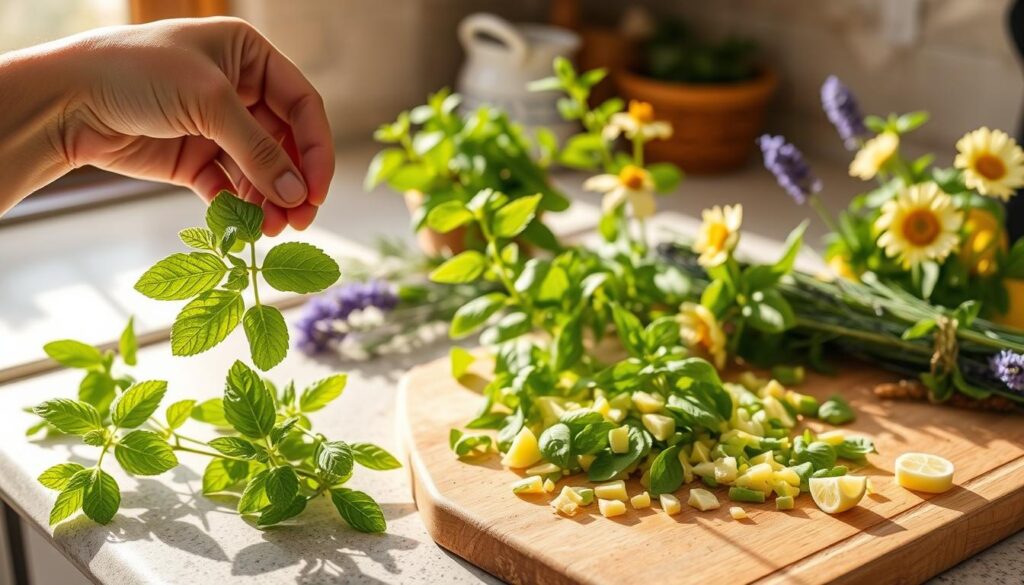
Common Pests and Diseases
Lemon balm, while relatively resistant to pests, can still face challenges from a few common pests of lemon balm, including aphids and spider mites. Recognizing the signs of infestations early can make a significant difference in maintaining the health of your plants. You should keep an eye out for wilting or discoloration, indicating potential threats. Implementing effective pest management for lemon balm requires vigilance and strategic actions to safeguard your garden.
Identifying Garden Threats
Inspect your lemon balm regularly for any signs of trouble. Common pests such as aphids often congregate on the undersides of leaves. If you notice any sticky residue or small insects, it’s time to take action. Similarly, spider mites can cause speckled leaves and webbing, making early identification crucial. If left unchecked, these pests can lead to more serious issues.
Natural Remedies with Companion Plants
Utilizing natural remedies for garden pests can create a balanced ecosystem while keeping pests at bay. Companion plants like marigolds and chives not only add beauty to your garden but also repel unwanted insects. The pungent aroma of chives can deter aphids, while the bright flowers of marigolds attract beneficial insects that prey on pests. Interplanting these species alongside your lemon balm not only enhances aesthetic appeal but also fortifies your pest management strategy.
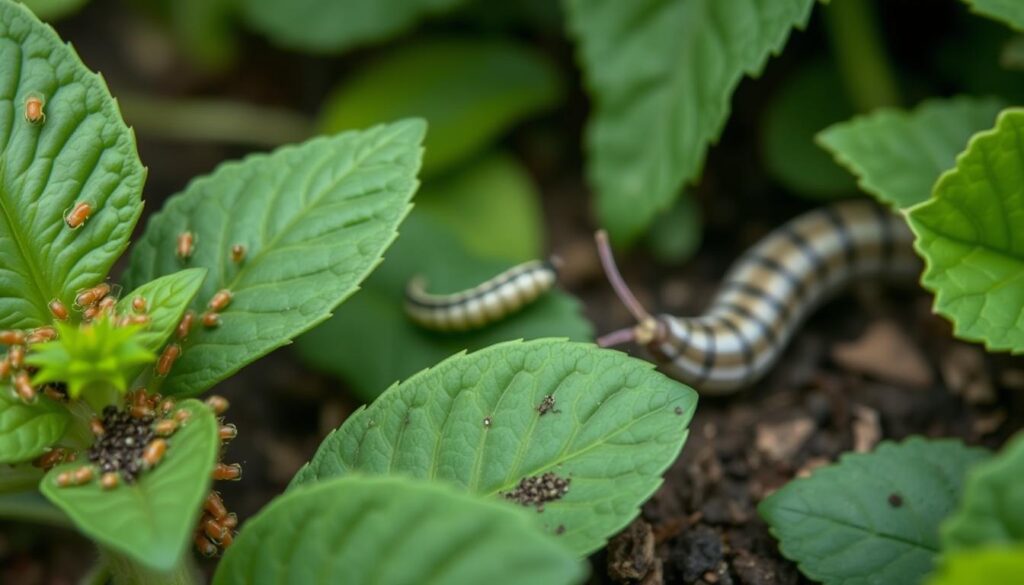
Conclusion: Successful Gardening with Lemon Balm
As you embark on your gardening journey with lemon balm, you’ll discover the numerous benefits of lemon balm companions. By strategically selecting plants that thrive alongside your lemon balm, you can create a vibrant, pest-resistant garden that enhances both productivity and aesthetics. Companion planting not only promotes healthier plants but also offers delightful flavor combinations in your kitchen.
Take time to explore the various tips for companion planting that can maximize the potential of your garden. Implementing the right combinations will ensure that each plant contributes to the overall health of the community garden you are cultivating. Remember, the beauty of gardening is in experimentation, so don’t hesitate to mix and match different varieties and observe their interactions.
Embrace the adventure of gardening with lemon balm, knowing that you are fostering a diverse and thriving green space. Each successful pairing is a step toward a more bountiful harvest and a deeper connection with nature. Your companion garden awaits the magic of your creativity, so get started today!


